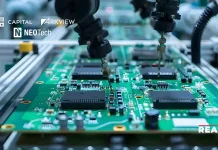MEMS (Micro-Electro-Mechanical Systems) sensors have emerged as a transformative technology, making significant contributions to various industries. These miniature devices, with their ability to sense and measure physical quantities, have revolutionized the healthcare, automotive, consumer electronics, and aerospace sectors.
By combining microelectronics and mechanical components on a single chip, these sensors have opened up new possibilities for sensing and control in a wide range of applications. According to Extrapolate, the global MEMS sensor market is forecasted to garner a valuation of $36.93 million by 2028. In this discussion, we will explore the fundamental principle, benefits, and application, shedding light on the impact they have had on our modern world.
What Is a MEMS Sensor?
MEMS sensors, or micro-electro-mechanical systems sensors, are tiny devices that revolutionize the measurement of physical quantities. Compact, efficient, and versatile, they can be integrated into a wide range of applications. Whether measuring motion, pressure, temperature, or chemical properties, these sensors provide accurate, real-time data, enhancing various industries.
How Does a MEMS Sensor Work?
A micro-electro-mechanical systems sensor is a miniature device that combines microelectronics and mechanical components on a single chip to sense and measure physical quantities. These sensors convert a measured mechanical signal into an electrical signal, enabling them to provide valuable data for various applications. These sensors utilize microstructures, microsensors, micro-actuators, and micro-electronics integrated into the same chip, allowing them to act as sensors or actuators. They have found widespread use in industries such as automotive, healthcare, consumer electronics, and aerospace, enabling advancements in smart devices, IoT technologies, and autonomous systems. With their small size, low power consumption, and high sensitivity, micro-electro-mechanical systems sensors have become an integral part of modern technology, driving innovation and enhancing our everyday lives.
Are MEMS Sensors Sensitive to Environmental Factors?
These sensors are known for their high sensitivity to various environmental factors. These sensors offer superior performance compared to conventional sensors, with enhanced sensitivity, selectivity, and response time. They can be fabricated at a lower cost due to batch processing, and on-chip signal conditioning units can further improve their performance. However, it is important to note that MEMS sensors can be sensitive to factors such as temperature, humidity, mechanical noise, and stimulus accuracy. Environmental conditions can affect the accuracy and stability of these sensors, and careful consideration must be given to testing and calibration processes to ensure reliable and accurate measurements. Despite these sensitivities, these sensors have become widely utilized across industries due to their small size, high sensitivity, and ability to operate in harsh environments, making them invaluable devices in applications ranging from automotive and aerospace to healthcare and environmental monitoring.
Applications of MEMS Sensors
MEMS sensors, including MEMS microphones, MEMS accelerometers, and MEMS pressure sensors, MEMS automotive have various applications including:
- Automotive: extensively utilized in safety systems such as airbags, stability control, and anti-lock braking systems. They also contribute to engine management, tire pressure monitoring, and electronic parking brakes.
- Consumer electronics: These sensors are found in smartphones, wearable devices, and virtual reality equipment. They enable functionalities like motion sensing, orientation detection, and gesture recognition, enhancing the user experience and enabling new features.
- Healthcare: Utilized in biomedical monitoring and diagnostic tools. They measure vital signs, detect movement, and monitor drug delivery systems, contributing to advancements in healthcare technology.
- Industrial Automation: Employed in industrial automation and manufacturing processes. They enable precise measurement of parameters such as pressure, temperature, and vibration, ensuring optimal performance and quality control.
- Aerospace and Defense: Used in aircraft, helicopters, drones, and spacecraft. They provide critical data for navigation, attitude control, and structural health monitoring, enhancing safety and performance.
- Environmental Monitoring: Applied in environmental monitoring, measuring parameters like air quality, humidity, and temperature. They enable real-time data collection for climate studies, pollution control, and weather forecasting.
- Consumer Products: Integrated into various products like gaming consoles, digital cameras, and smart home devices. They enable motion control, image stabilization, and environmental sensing, enhancing functionality and the user experience. Companies like Analog Devices offer MEMS accelerometer and gyroscope solutions for these products. These solutions provide designers with discrete components and plug-and-play iSensor MEMS subsystems, delivering highly integrated, multi-axis solutions for various consumer applications.
Are MEMS Sensors More Durable Than Other Types Of Sensors?
MEMS sensors offer several advantages over other types of sensors, making them highly desirable across various industries. Here are some key benefits:
- Compact Size: Incredibly small, these can be integrated into compact devices and systems, enabling the development of smaller, more portable devices suitable for space-limited applications.
- Low Power Consumption: Designed to operate efficiently with minimal power requirements, these sensors are ideal for battery-powered devices, extending battery life and improving energy efficiency.
- High Sensitivity: These exhibit high sensitivity, detecting and measuring even subtle changes in physical quantities. This precision makes them perfect for applications requiring accurate measurements.
- Cost-Effectiveness: Manufactured using batch fabrication techniques similar to those used for integrated circuits, sensors can be mass-produced, reducing manufacturing costs and making them more affordable than traditional sensors.
- Versatility: Capable of sensing and measuring a wide range of physical parameters, including motion, pressure, temperature, humidity, and gas composition, these sensors are adaptable to various applications across industries.
How Long Do MEMS Sensors Typically Last?
The lifespan of micro-electro-mechanical systems sensors can vary depending on various factors such as the specific application, operating conditions, and maintenance practices. While there is no specific standard lifespan for these sensors, they are generally designed to be durable and withstand harsh environmental conditions.
Can MEMS Sensors Be Repaired When Damaged?
MEMS sensors are generally not designed to be repaired once they are damaged. Due to their microscopic nature and complex internal structures, repairing a damaged sensor is often not practical or feasible. Unlike conventional electronic parts that may be repairable at home, these sensors typically require replacement if they are damaged.
If a sensor is damaged during the design or manufacturing process, it is usually necessary to purchase a new sensor. Repairing the sensor at the component level is not a common practice due to the intricate nature of MEMS technology.
End Note
In conclusion, the development and application of MEMS (Micro-Electro-Mechanical Systems) sensors have revolutionized various industries, ranging from automotive and healthcare to consumer electronics and aerospace. Throughout our discussion, we have explored the fundamental principles and functionalities of MEMS sensors, delving into their miniaturized size, low power consumption, and high sensitivity. With continuous advancements along the way, these systems are sure to transform industries.
Browse More Posts:-




